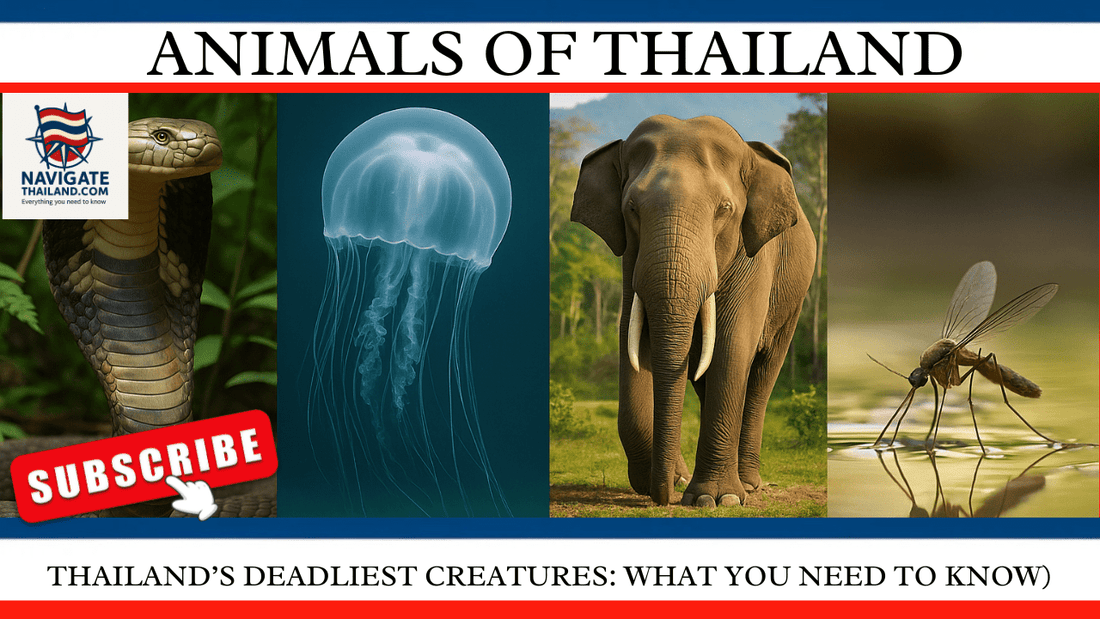
Thailand’s Deadliest Creatures: What You Need to Know
Share
From the jungles of Chiang Mai to the coral reefs of Koh Tao, Thailand’s wildlife is as fascinating as it is dangerous. While most animal encounters are harmless, the country is also home to some of Southeast Asia’s deadliest creatures—including venomous snakes, biting insects, marine hazards, and territorial mammals.
Whether you’re jungle trekking, diving in tropical waters, or just wandering off the beaten path, this guide will help you stay aware of the risks and know how to protect yourself during your adventures in the Land of Smiles.
⸻
1. Venomous Snakes
Thailand is home to over 200 species of snakes—about 60 of which are venomous. Though snake encounters are rare for most tourists, some of the deadliest include:
• King Cobra – The world’s longest venomous snake, found in forests across the country. Highly venomous and territorial.
• Monocled Cobra – Often found near rice fields and rural areas in central Thailand.
• Krait (Bungarus) – Nocturnal and extremely venomous. Often bite while victims are asleep.
• Pit Vipers – Green tree vipers are often camouflaged in trees and bite if disturbed.
🧭 Where to See (or Avoid) Them: Jungle areas in Chiang Mai, Khao Sok National Park, and rural provinces like Ubon Ratchathani and Nakhon Si Thammarat. Most bites occur in rural areas or when hiking off-trail.
🚑 Safety Tip: Always wear covered shoes in grassy or forested areas. Never try to handle a snake. In case of a bite, stay calm, immobilize the limb, and seek emergency medical treatment immediately.
⸻
2. Box Jellyfish
Though Thailand’s waters are mostly safe, the box jellyfish has made occasional appearances around the Gulf of Thailand, including Koh Samui, Koh Phangan, and Koh Tao. A sting from this translucent creature can cause cardiac arrest within minutes.
🧭 High-Risk Areas: Eastern Gulf islands during the rainy season (July–October).
🚑 Safety Tip: Swim at beaches with vinegar stations (used to neutralize the sting), avoid swimming at dawn or dusk, and follow lifeguard warnings. If stung, apply vinegar and seek urgent medical attention.
⸻
3. Centipedes and Scorpions
In rural and jungle regions, giant centipedes and Asian forest scorpions are common. While their stings or bites are rarely fatal, they cause intense pain, swelling, and possible infection.
🧭 Where They Live: Forest floors, under rocks, and occasionally inside bungalows or shoes in northern Thailand and Isaan.
🚑 Safety Tip: Shake out shoes and clothes before putting them on. Use mosquito nets when sleeping in rural areas. Most bites resolve on their own, but seek care if symptoms worsen.
⸻
4. Mosquitoes (Dengue, Malaria, and Zika)
Thailand’s most dangerous killer might not be the snake or jellyfish—but the mosquito. These tiny insects transmit deadly diseases including:
• Dengue Fever – Common in urban and rural areas.
• Malaria – More common in border regions near Myanmar, Laos, and Cambodia.
• Zika Virus – Rare, but present, especially dangerous for pregnant women.
🚑 Prevention Tip: Use DEET-based insect repellent, wear long sleeves, and sleep under a mosquito net in rural areas. Avoid stagnant water where mosquitoes breed.
⸻
5. Wild Elephants
While domesticated elephants are common in sanctuaries, wild elephants can be highly dangerous if provoked or startled. In Khao Yai National Park and other reserves, elephants have been known to charge vehicles or hikers.
🧭 Where to Spot Them: National parks such as Khao Yai, Kui Buri, and Kaeng Krachan.
🚑 Safety Tip: Stay inside vehicles in national parks, keep your distance, and never block their path. Observe from afar and never feed wild elephants.
⸻
6. Leeches and Ticks
Not deadly, but worth mentioning: forest hikes often expose you to leeches and ticks, which can carry disease and cause nasty bites.
🧭 Where They’re Found: Rainforests in Chiang Mai, Kanchanaburi, and the south.
🚑 Prevention Tip: Use leech socks when hiking and do regular body checks for ticks.
⸻
Final Thoughts: Should You Be Worried?
Thailand’s biodiversity is one of its greatest treasures—and, occasionally, its most underestimated danger. But with basic precautions, almost all risks can be avoided. Knowing which creatures to be aware of and where they live helps ensure your adventure remains thrilling—but not life-threatening.
Remember, wildlife encounters in Thailand are rarely deadly. But they are part of what makes the country’s landscapes so wild, beautiful, and worth exploring.
⸻
🐍 Have You Spotted One of Thailand’s Deadly Creatures?
Drop your stories in the comments below or tag us on Instagram with your wildlife encounter! And if you found this post helpful, share it with fellow travellers. Don’t forget to subscribe to our YouTube channel for real-life wildlife footage and regional safety guides.
⸻
References
• World Health Organization – Thailand Vector-Borne Diseases
• National Parks of Thailand – Safety Guidelines
• Bangkok Post – Wildlife News and Incidents
• Hall of Opium Museum, Chiang Rai
⸻
Read more of our Thailand blog series:
Thai Food Guide:Traditional Recipes and Street Eats
Everything Travellers Need to know
Thailand travel ebooks and language guides
Thailand Travel Apparel & Souvenir Gifts
Subscribe to our YouTube channel Navigate Thailand to see our most popular Thailand travel blogs turned into videos:
Navigate Thailand YouTube channel





































































































































